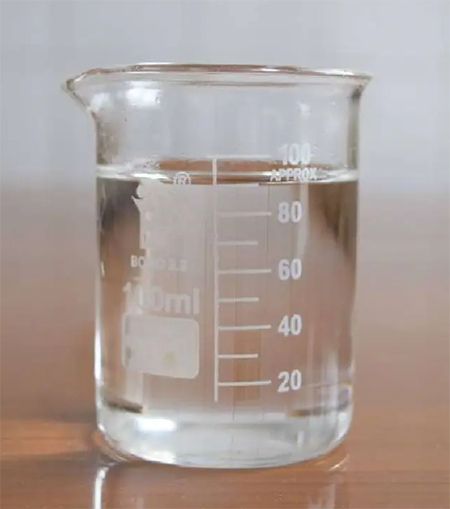Application of 2-ethylhexanol
Introduction
2-Ethylhexanol is an organic compound with a molecular formula of C8H18O[1]. It is used in the production of plasticizers, defoamers, dispersants, mineral processing agents and petroleum additives, as well as in printing and dyeing, paints, films, etc. Colorless flammable liquid with special odor. Freezing point -75°C, relative density 0.8344 (20/20°C), refractive index 1.4316, flash point 81.1°C, viscosity (20°C) 9.8mPa·s, vapor pressure (20°C) 48Pa. It is miscible with alcohol, ether and chloroform, soluble in water about 720 times, and the solubility in water is only 0.1% at 20°C. The azeotrope formed with water is 20% water, and the azeotrope is 99.1%.

Picture 1 2-Ethylhexanol liquid
Acetaldehyde condensation method
Acetaldehyde is condensed into butanolaldehyde, dehydrated to obtain crotonaldehyde, hydrogenated to obtain n-butyraldehyde, and then two molecules of n-butyraldehyde are condensed and dehydrated to obtain 2-ethyl (-2-) hexenal, which can be prepared by hydrogenation. 2-Ethyl(-1-)hexanol[2].
Oxygenation
Using propylene and synthesis gas as raw materials, butyraldehyde is generated by oxo reaction, two molecules of butyraldehyde are dehydrated by condensation to obtain 2-ethyl (-2-) hexenal, and then 2-ethyl (- 2-ethyl (-) can be prepared by hydrogenation. 1-) Hexanol
Acetaldehyde condensation method
First, two molecules of ethanol are condensed to form butanol aldehyde; then dehydration generates crotonaldehyde, which is hydrogenated to n-butyraldehyde; n-butyraldehyde is then hydrogenated to n-butanol; if it is dehydrated by condensation, it will generate 2-ethylhexenal, further hydrogenated to obtain the final product 2-ethylhexanol. Or adopt the high-pressure oxo synthesis method, use propylene, carbon monoxide and hydrogen as raw materials, and use cobalt tetracarbonyl hydrogen as a catalyst to react to synthesize n-butyraldehyde and isobutyraldehyde. N-butyraldehyde and isobutyraldehyde are hydrogenated with copper or nickel as catalyst. n-Butyraldehyde is hydrogenated in gas phase or solid phase to generate n-butanol; after initial distillation, n-butanol is purified in a two-column distillation system. Using sodium hydroxide as a catalyst to condense and dehydrate n-butanol to obtain 2-ethylhexenal. Hydrogenation of 2-ethylhexenal in the presence of nickel catalyst at a certain temperature and pressure to produce iso-2-ethylhexanol
Heptene process catalyzed by rhodium catalyst
The rhodium catalyst can be used to catalyze the carbonylation of heptene to produce octanol in one step. Rhodium catalysts Rh2AcO4 and [RH(NH3)5Cl]Cl2 can both be used as catalyst precursors for the reaction (phosphorus should be added to the catalyst when using, such as tributyl The phosphine activates the catalyst so that the main product is the n-alcohol, not the aldehyde)
Other methods
Using coconut oil as a raw material, in the presence of a copper-chromium catalyst, 2-ethylhexanol is prepared under high pressure through hydrogen
Application
1.2-Ethylhexanol is mainly used in the production of plasticizers. The main products are: dioctyl phthalate (DOP), dioctyl oxalate (DOA), trioctyl trimellitate (TOTM), and Ester plasticizers and cold-resistant auxiliary plasticizers of dicarboxylic acids such as phthalic acid, azelaic acid, and sebacic acid. 2-Ethylhexanol can be used as a defoamer for white latex, but it has poor foam breaking and foam suppression capabilities. When 2-ethylhexanol is used in the mixed solvent of nitro spray paint, it can prevent the whitening of the paint film. 2-Ethylhexanol is an excellent solvent and can be used in paper sizing, latex and photography. 2-Ethylhexanol is also used in the production of surfactants, dispersants, lubricants, emulsifiers, antioxidants, mineral processing agents, mercerizing agents and petroleum additives. 2-Ethylhexanol is also commonly used in baked goods, frozen dairy products and puddings as a permitted flavoring.
Storage notes
Store in a cool, ventilated warehouse. Keep away from fire and heat sources. It should be stored separately from oxidants, acids, etc., and should not be mixed. Equipped with the appropriate variety and quantity of fire equipment. Storage areas should be equipped with emergency release equipment and suitable containment materials
Shipping notes
When transporting by rail, it should be assembled in strict accordance with the Dangerous Goods Compatibility Table in the "Rules for the Transport of Dangerous Goods" of the Ministry of Railways. Before transportation, check whether the packaging container is complete and sealed, and ensure that the container does not leak, collapse, fall or damage during transportation. It is strictly forbidden to mix and transport with oxidants, acids, edible chemicals, etc. Transport vehicles and ships must be thoroughly cleaned and disinfected, otherwise other items cannot be shipped. When shipping, the assembly location should be far away from the bedroom, kitchen, and isolated from the engine room, power supply, fire source and other parts. When transporting by road, drive according to the prescribed route, and do not stop in residential areas and densely populated areas
Reference
1 Li Fahong, Chen Xiaoqing, Jia Liying, etc. Determination of trace gallium by 2-ethylhexanol extraction-atomic absorption spectrometry. 2000
2 Cheng Wenying. Recovery of boron from acidification of boron extraction from Dongtai Jiner Lake with 2-ethylhexanol. 1998
Related articles And Qustion
Lastest Price from 2-Ethylhexanol manufacturers

US $1.45-1.35/kg2025-07-10
- CAS:
- 104-76-7
- Min. Order:
- 1000kg
- Purity:
- ≥99.7%
- Supply Ability:
- 100 tons

US $0.00/kd2025-05-17
- CAS:
- 104-76-7
- Min. Order:
- 200kd
- Purity:
- 99%
- Supply Ability:
- 200000



